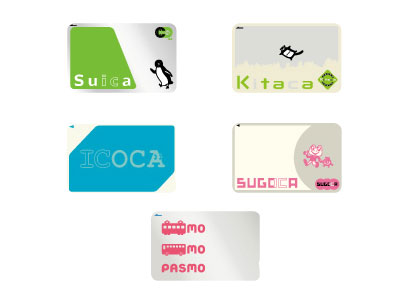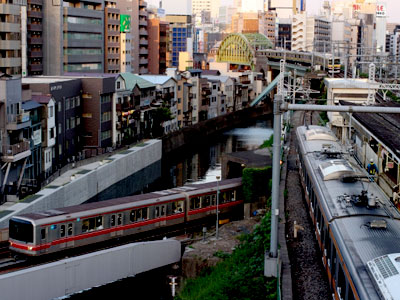Finding your way around Japan can seem disorienting at first—signs are mostly written in Japanese, there are no street names, and there are too many doors on their buses to know what to do with. However, getting clued up about how things work in Japan can make life much easier and more manageable.
Use the Topics side menu on the left for more information.
Layout of Japanese Cities
As previously mentioned, Japanese cities have no street names (except for Kyoto and some other large cities). This can make it unsettling if you’re in an unfamiliar area of town and can't find your way. Japanese people tend to use landmarks to get around, so if you ask someone for directions they will probably tell you to "turn right at xxx konbini" or "go straight on at the traffic lights".
Having no road names can also make it difficult to get a taxi anywhere since you can't simply ask to be taken to a specific road. Instead, you will either have to give the taxi driver the address of your destination, the name of the nearest landmark, or tell them where to go as you are driving.
Getting a general understanding of how Japanese cities are laid out will help you to get hold of your bearings a little more, so let's take a look.
Understanding Japanese Addresses
As you will see below, Japanese cities are subdivided by area from the largest geographical area to smallest—and the bigger the city, the more areas there are and the longer the address becomes. Let's take a look at the following fictional Tokyo address:
123-4567 Tokyo-to, Shibuya-ku, Hommachi 2 Chome, 4-7, JFS Mansion 123
This roughly translates as the following:
123-4567: Postal/ZIP code
Tokyo-to: "Tokyo Metropolis" —"to" is added to the end of Tokyo to indicate it is the capital city. This is for Tokyo only, and other places in Japan use different terms: Kyoto and Osaka use "fu", which means "municipality" (Kyoto-fu = Kyoto Municipality); the 43 prefectures of Japan are called "ken" (Nagoya-ken = Nagoya Prefecture); and "shi" is used to mean "city" (Kyoto-shi = Kyoto City).
"to" and "fu" are often omitted in English, while "ken" and "shi" are always translated to avoid confusion between the two (Nagoya City =/= Nagoya Prefecture).
Shibuya-ku: "Shibuya Ward" — Each metropolis (Tokyo), municipality (Kyoto, Osaka) and large city is broken down into large areas called "wards", which are called "ku" in Japanese. This line is skipped completely for smaller cities and towns that do not have wards.
Hommachi: "Hon Town" — Wards are further broken down into "towns", known as "machi" or "cho", which are added to the end of the town name. While 'Hon Town' is the literal translation in English, you should treat 'Hommachi' as a proper noun and use it as it is for the English version of the address.
2 Chome: "2nd District" — Towns are broken down into districts, which are smaller areas that make up each town. Each district is given a number followed by the word for district,"chome". However, "chome" is often left untranslated in English. Smaller cities and towns may not be big enough to have "chome", so this line can be omitted from the address.
4-7: "Block 4, Building 7"— Each district (chome) or town (machi/ cho) is broken down into blocks (ban), which are numbered (4-ban). Then, each building in a block will be given its own number, called "go" (7-go). However, in English this is left untranslated and simply written as "4-7".
JFS Mansion: This is just the name of the building.
123: This is just the room number.
Writing Addresses in English
While you can just use the Japanese version of the address when sending mail to Japan, it's also possible to write it in English. However you must make sure to reverse the order of the Japanese version, as western addresses are typically written in ascending order starting from the smallest area.
So, the English version of our Tokyo address would be as follows:
123 JFS Mansion, 4-7, Hommachi 2 Chome, Shibuya Ward, Tokyo 123-4567
It is also common both in Japanese and English to condense the "chome" number (2 Chome) and block number (4-7) using a hyphen ("2-4-7"). The chome number must always come before the block number. For this reason the following address is also correct:
123 JFS Mansion, 2-4-7, Hommachi, Shibuya Ward, Tokyo 123-4567
IC Cards

IC cards are prepaid smart cards which you can top up at ticket vending machines. There are many regional kinds of IC cards (Suica, Kitaca, Icoca, Sugoca etc.) and they are generally compatible in all regions. You can buy them at ticket machines or ticket counters at larger railway stations.
In the bigger cities, you can use IC cards to pay for bus, metro and train fares instead of cash. However, you can only use them for local journeys within the same IC card range; for example, you cannot swipe on at Tokyo and off at Osaka, as these are two different IC card networks. Furthermore, you cannot use them on shinkansen, airport limousines or highway buses.
To pay for your train or metro fare, touch the IC card to the card reader at the automated ticket gate on both ends of your journey. For buses, touch your card to the reader by the ticket machine when getting on the bus, then again on the machine by the driver when getting off. In both cases the fare will be deducted automatically when you exit.
Trains

Japan is one of the most famous countries in the world when it comes to trains—and for good reason! They're clean, fast and run like clockwork (2 minutes late is considered severely delayed!) Sure, compared to some countries they are expensive, but to others they're great value considering the service you get is nothing short of impeccable.
Train Classes
Japan has several different 'speeds' of train and the fare goes up for each category:
Local (futsuu-densha): Local trains are the slowest type as they stop at every station.
Rapid (kaisoku): The same price as a local ticket, but rapid trains skip a few stops along the way.
Express (kyuko): Express trains stop at fewer stations than rapid trains, making them slightly faster.
Limited Express (tokkyu): Limited express trains only stop at major stations. Some rail providers (such as JR Rail) charge a special fee for this category on top of the base fare.
Bullet Train (shinkansen): The fastest trains in the world, the shinkansen run on their own tracks and platforms and only stop off at the most major of destinations. They also require an extra fee on top of their base fare.
Seats
Faster classes of trains, such as Limited Express and Bullet Trains, have 'Standard Cars' and 'Green Cars' (first class). Standard Cars have both 'reserved' (shitei-seki) and 'free-seating' (jiyu-seki) available. Green Cars are usually reservation-only and are more spacious, but significantly more expensive. Slower trains tend to only have free-seating, and Green Cars are usually not available.
Train Etiquette
All trains are non-smoking, except those with designated smoking rooms. Just like on buses, it is considered impolite to speak on the phone while in your seat. If you must use your phone, it is best to go to the door area. Eating is allowed, and many people bring food with them. Faster classes of trains may have food trolleys where you can buy snacks and drinks from the attendant.
Rail Passes
There are several rail passes available that offer unlimited or reduced-fare travel within a given time limit:
JR Pass:
The most well-known rail pass available, the JR Pass is an extremely good-value pass that gives you unlimited travel within the 1,2 or 3 weeks of its validity (depending on which version you buy). There are separate passes available for Standard Cars and Green Cars. The pass can be used on any class of train belonging to Japan Railways, including all shinkansen except the Nozomi and Mizuho services; it can also be used with regional JR bus services and a limited number of highway buses.
This pass is only available to non-Japanese who are travelling as a "Temporary Visitor"—your passport will be stamped as such upon entry to the country. People living in Japan or those on longer permits cannot obtain this pass, even if they hold a foreign passport. The pass must be purchased via Exchange Order at a travel agency outside Japan. After arriving in Japan, the traveller must present the Exchange Order and their passport at a JR Ticket Office (midori no madoguchi) and fill in a form to specify the start date of the pass.
Seishun Juhachi Kippu (Youth 18 Pass):
Despite its name, this pass can be used by people of any age and is available to Japanese nationals, expats and tourists alike. This is a seasonal pass that is only valid during three limited periods of the year, falling in Spring, Summer and Autumn, and can be purchased at JR stations nationwide. (See japan-guide.com for more information on these periods (external link))
This pass allows the traveller to get 5 days' worth of unlimited travel on local and rapid JR trains for a heavily reduced price. The pass will be stamped at the manned ticket gate (you cannot put it through the automated ticket gate) and can be stamped up to 5 times—once for each day it is used. One days' worth of travel starts when the ticket is stamped and will be valid until midnight of that day, allowing you to travel as far as you want during that time.
How you split up the 5 days is up to you. If you are traveling together as a group, you can split the pass between you: 1 person travelling can use it 5 times; 2 people can use it for 2 days and 1 person uses it on the 5th day; 5 people can all use it on the same day; and so on. The 5 days do not need to be consecutive days either, as long as the card is still within the limited validity period.
As the pass can only be used on infrequent local and rapid trains, it is recommended to plan an itinerary ahead of time to make sure you can reach your destination in one day. Obviously these trains are slower, so tourists will have less time for sight-seeing due to spending a longer time 'on the road'.
Regional JR Passes
Aside from the two nationwide passes above, there are also several regional JR passes valid for different lengths of time and in different regions or tourist areas across Japan. These passes are good value if you are only travelling around one area of the country. (See japan-guide.com for more information (external link))
Buying a Train Ticket
Some ticket machines do not have an English-language feature, but it isn't a hard process when you know how to do it. In Japan, you select train tickets by fare rather than by destination, so before anything you need to find out how much the fare to your destination is.
1) Find the name of your destination on the rail network map above the ticket machine. Next to the station name there will be a number, which is the price of the fare in Japanese Yen.
2) Insert money into the machine and select the required number of tickets (skip this if you only need one).
3) The screen will display a list of fares, so select the one that you just looked up on the map.
4) Take your ticket(s) and change.
Of course, you could alternatively buy tickets over the counter, which may be easier if the station does not have an English version of the rail network map.
Buses
Local buses are an inexpensive way to get around and they often offer daily passes that make them even cheaper. The names of the stops will be displayed on a sign at the front of the bus and will usually be in English in bigger cities (but not in more rural places). Local buses often have two sets of doors—the back ones are for getting on and the front ones are for getting off.
When you get on the bus, take a ticket from the ticket dispenser by the door. You will notice the ticket will have a number on it, which is used to look up your fare. At the front of the bus you will see an electronic signboard next to the driver. The white numbers displayed on the board correspond to the number on your ticket, with the fare being the red number below this; for example, if your ticket says '5', find the number '5' written on the board and your fare will be the red number underneath (e.g 450 yen). Note that this red number will periodically increase the more the bus stops, so check the fare when you are getting off at the next stop.
When your stop is coming up, you need to press the bell on the wall. You pay for your fare at the machine next to the driver when you get off. You must pay with exact change, but if you don't have it you can also use this machine to break change before paying—just put in coins or a 1000 yen note into the money exchange slots and collect the change it gives you. To pay, just put your ticket with the exact fare in the slot on the top of the machine, then get off the bus.
Note that some buses (like those in Kyoto) have a flat fare system, which means you will pay the same fare regardless of how far you travel. If this is the case, you will not need to take a ticket or look up the fare, but simply pay when you get off. Tokyo metropolitan buses also have a different system, where you get on at the front and pay for your fare, then exit at the rear.
Our tips:
Check out HyperDia to look up train times and fares in English.





